Rajendra Chola I facts for kids
Quick facts for kids Rajendra I |
|
|---|---|
| Parakesari, Yuddhamalla, Mummudi Cholan, Gangai Kondan, Kadaram Kondan, Jayasimha Kula Kaalan | |
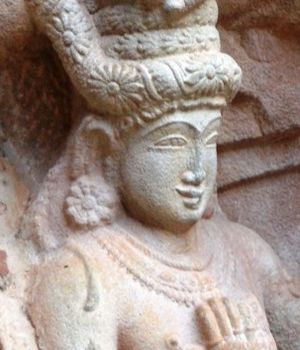
Sculpture of Rajendra Chola I represented as Lord Chandikeswara (Gangaikonda Cholapuram)
|
|
| Chola Emperor | |
| Reign | 1014 CE – 1044 CE |
| Predecessor | Rajaraja I |
| Successor | Rajadhiraja I |
| Co-Regent of the Chola Empire | |
| Reign | 1012 CE – 1014 CE |
| Emperor | Rajaraja I |
| Successor | Rajadhiraja I |
| King of Dakkinadesa King of Ruhuna |
|
| Reign | 1017 CE – 1044 CE |
| Predecessor | Kassapa VI |
| Successor | Rajadhiraja I |
| Born | Madhurantaka 971 CE Thanjavur, Chola Empire (modern day Tamil Nadu, India) |
| Died | 1044 CE (aged 73) Brahmadesam, Chola Empire (modern day Tiruvannamalai, Tamil Nadu, India) |
| Burial | End of 1044 CE Brahmadesam, Tamil Nadu, India |
| Spouse |
|
| Issue |
|
| Dynasty | Chola |
| Military career | |
| Service | |
| Years of service | 992 – 1044 CE |
| Rank | Senathipathi (992 – 1014 CE) Chakravarti (1014 – 1044 CE) |
| Father | Rajaraja I |
| Mother | Vanavan Mahadevi alias Tribhuvana Mahadevi |
| Religion | Hinduism |
| Signature | |
Rajendra Chola I (born around 971 CE – died 1044 CE) was a powerful Chola Emperor. He ruled from 1014 to 1044 CE. People often call him Rajendra the Great. He was also known as Gangaikonda Chola, meaning "Bringer of the Ganges". Another title was Kadaram Kondan, meaning "Conqueror of Kedah".
Rajendra is famous for his important role in South Asia during the early 11th century. He supported arts and trade. He also made the Chola Empire the biggest it had ever been. He was born in Thanjavur to Rajaraja I and Queen Vanavan Mahadevi. Rajendra became a co-ruler with his father in 1012. He took the throne fully in 1014 after his father passed away.
During his rule, the Chola Empire was a major power in the Indian subcontinent. It grew through trade and conquests across the Indian Ocean. This made Rajendra one of the few Indian kings to conquer lands outside South Asia. He started his career in the Chola Army. He fought against the Western Chalukyas and the rulers of Anuradhapura. He also stopped rebellions in the Chera and Pandiya kingdoms and in Sri Lanka.
As Emperor, he finished conquering Anuradhapura. He brought a large part of Sri Lanka under Chola rule. Rajendra also defeated the kingdoms of Kalinga and Vengai. He took over the islands of Laccadives and the Maldives. He renamed the Maldives "Twelve Thousand Islands and the Ocean Where Three Waters Meet". These islands became important naval bases. In his Southeast Asia campaign, he conquered Srivijaya, Kedah, Tambralinga, and Pegu. This made the Chola Empire very powerful and influential in Southeast Asia.
Rajendra fought many wars against the Pala dynasty. He gained a lot of treasure from these wars. He used this treasure to build the city of Gangaikondacholapuram. This city became the Chola capital and a big center for trade for centuries. The city had a huge artificial lake and strong defenses. It also had the beautiful Brihadisvara Temple. Rajendra was a religious man and followed Shaivism, a part of Hinduism. He also welcomed Buddhism and built many stupas in Southeast Asia and South India.
One of Rajendra's lasting impacts was new ways of trading. His control over the Strait of Malacca and other coastal areas led to a new trade system called "emporia". This meant exporting goods based on demand. This system made trade more profitable for the Empire. More trade led to a stronger military, which helped expand trade even more. The Khmer Empire was a key ally and trading partner. This allowed the Cholas to trade as far as Song China. Rajendra even added Chinese ships to his navy. These trade networks also reached west to Arabia, North Africa, and Turkic lands for the spice trade.
Rajendra was followed by his son Rajadhiraja I. Rajadhiraja ruled from 1044 to 1054.
Contents
- Becoming Emperor: Rajendra's Early Life and Rule
- Rajendra's Military Campaigns and Conquests
- Rajendra's Major Conquests: A Timeline
- Battles in Southern India
- Conquering Sri Lanka: The Anuradhapura Campaign
- Conquering the Ganges: Rajendra's Northern Expedition
- Southeast Asia Campaign: Across the Ocean
- Rajendra's Passing
- Rajendra's Personal Life and Family
- Rajendra's Children
- Rajendra's Achievements and Legacy
- Rajendra in Popular Culture
- Images for kids
- See also
Becoming Emperor: Rajendra's Early Life and Rule
Rajendra I was born around 971 CE. He was the son of Rajaraja I and Queen Vanavan Mahadevi. Rajendra had a younger brother, Araiyan Rajarajan, who was a general.
In 1012, Rajendra became a co-ruler with his father, Rajaraja I. This meant he helped manage the Chola Empire. When his father died in 1014, Rajendra became the full emperor. In 1018, Rajendra made his own son, Rajadhiraja, a co-ruler. Rajadhiraja then ruled the Pandya dynasty from 1018 to 1044.
Rajendra's Military Campaigns and Conquests
Rajendra started his military journeys even before he became emperor. In 1012, he captured Aduthurai and Vanavasi in Tamil Nadu. In 1013, he took Kollipaakkai in Andhra Pradesh. These early victories were for his father, Rajaraja I. In 1014, he led an army against Irratiapaadi ElaraIiakam in Karnataka and Maharashtra. He captured its capital, Mannaikadakkam.
After becoming emperor in 1014, Rajendra continued his conquests. In 1016, he sent an army overseas to Sri Lanka. He brought the entire Anuradhapura Kingdom under his control. In 1017, he conquered Kudamalai Nadu in eastern Kerala.
Expanding the Empire: Islands and Northern India
In 1018, Rajendra's forces crossed the seas again. They captured many islands in the Maldives and Lakshadweep. This included Kavaratti island. In 1019, he fought against Irrataipaadi Elaraiillakam again. This time, he recaptured the region after a battle in Musangi.
Rajendra then set his sights on northern India. In 1021, he captured Sakkarakkoattam in south Chhattisgarh. From there, he split his army into two groups. One went towards the Ganges River in the north. The other went northwest. Rajendra stayed at Sakkarakkoattam until both expeditions were done.
The northern army reached the Ganges River in 1022. They conquered Odda Vishayam (Odisha), Kosala Naadu (north Chhattisgarh), and other regions. This expedition ended in 1022. Rajendra's records from 1023 describe these conquests.
Building a New Capital: Gangaikondacholapuram
After his army returned from the Ganges region, Rajendra earned a new title: "Gangaikondaan". This means "the one who captured the Ganges". He also gave the title "Gangaikonda Cholan" to his younger brother who led the Ganges expedition.
Rajendra then began building a new city called "Gangaikonda Cholapuram". He built a new Siva Temple there called "Gangaikonda Cholaeswarem". He also created a large temple water tank called "Chola Gangam". This tank was filled with holy water brought from the Ganges River. The Essalam Copper Plates confirm that Rajendra built this new city and temple. The main deity in the temple was a huge Siva Lingam, 13 feet tall and 20 feet around. It is the largest Lingam in any Siva Temple.
Other temples were also built to celebrate his victories. The "Vijayamkonda Cholaeswarem" Siva temple in Erumbur was built for his victory over Srivijaya. The "Kadaremkonda Cholaeswarem" Siva temple in Kudimallur was built for his victory over Kadaram. These granite temples show the Cholas' great power and achievements.
Conquests in Southeast Asia
Rajendra's overseas expeditions began in 1023. A large fleet of Chola ships sailed to Sri Vijaya (Palembang) in Sumatra, Indonesia, and captured it. They then took Malaiyur in south Sumatra. The fleet then captured Mevilibangham (Bangha Island) and Pannai in east Sumatra. They also took Ilamuridesam in north Sumatra.
The forces then moved to Malaysia. They captured Vallaipandur in north-east Malaysia and Kadarem in north-west Malaysia. From there, they went north to Ilankasokam (south-east Thailand) and Mathamalingam (east Thailand). They also took Thalaitakkolam (south-west Thailand). On their way home, they captured Manakkavaarem in the Andaman and Nicobar Islands. They also took Magpapaalam, a seaport city in present-day south Myanmar. The Southeast Asian expedition ended in 1024. Rajendra's records from 1025 describe these victories.
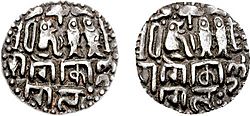
After his triumph over Kadaram, Rajendra took another new title: "Kadaremkondaan". One of his grandsons, who led the Kadaram expedition, was given the title "Kadaremkonda Cholan". Some villages in Tamil Nadu still have names like Kidarankondan and Kadaramkonda Cholapuram.
Rajendra's Major Conquests: A Timeline
| Year | Conquest | Result |
|---|---|---|
Chola Empire's Reach Around 1030 CE |
||
| 992–1008 CE | Chalukya–Chola wars | Cholas took over several areas from the Western Chalukyas. |
| 993–1017 CE | Conquest of Sri Lanka | Cholas took over all of Sri Lanka. The Anuradhapura Kingdom king became a puppet ruler. |
| 1018–1019 CE | Conquest of the Chera Kingdom and Pandya Kingdom | Cholas took over the Cheras and Pandyas. |
| 1019 CE | Conquest of Kalinga | Cholas took over Kalinga. |
| 1020 CE | Battle of Musangi | Cholas attacked and destroyed Malkheda. They took most of the Western Chalukyas' land. |
| 1023 CE | Conquest of the Ganges | Cholas took over Vangadesam (Bengal) and Odda (Odisha). |
| 1023–1025 CE | Conquest of Pegu | Cholas took over the city of Pegu (Myanmar). |
| 1025 CE | Conquest of the Srivijaya Empire | Srivijaya and nearby kingdoms became controlled by the Cholas. |
| 1025 CE | Conquest of Kedah | Cholas took over Kadaram (Kedah). |
Battles in Southern India
Early Military Actions
Rajendra began leading military campaigns in 1002 CE. These included fighting the Rashtrakutas and the Western Chalukyas. He conquered Chalukyan areas like Yedatore and Banavasi. He also took their capital, Manyakheta. Rajendra built a Siva temple in Bhatkal. He also conquered Kollipakkai in present-day Telangana.
In 1018 or 1019 CE, Rajendra marched into the Pandya and Chera Perumal kingdoms. He conquered both regions. Rajendra then made one of his sons a viceroy, or governor. His son was named Jatavarman Sundara Chola-Pandya and ruled from Madurai.
Chola–Chalukya Conflicts
Rajendra fought many battles with the Western Chalukyas. From 992 CE to 1008 CE, he raided and took over towns like Rattepadi and Banavasi.
In 1015 CE, Jayasimha II became the king of the Western Chalukyas. He tried to win back lands lost by the previous king. At first, Jayasimha II was successful because Rajendra was busy in Sri Lanka. In 1021 CE, after the king of Eastern Chalukyan Vengi died, Jayasimha supported a different person for the throne. Rajendra helped his nephew, Rajaraja Narendra, win the throne instead.
Rajendra fought Jayasimha in the Battle of Maski. He led an army of 900,000 soldiers. He defeated Jayasimha II in 1019–1020 CE. Rajendra also led his army in Vengi and removed the rulers there. Vengi later became the place where Rajendra's nephew was crowned.
Conquering Sri Lanka: The Anuradhapura Campaign
Under his father Rajaraja I, Rajendra and his commander Vallavaraiyan Vandiyadevan invaded Sri Lanka. The capital city of Anuradhapura was attacked by the Chola army. The capital was moved to Polonnaruwa, which was renamed "Jananathamangalam". A Chola official built a Shiva temple there called Rajarajeshvara. The Chola-controlled areas in Sri Lanka were named Mummudicholamandalam.
Rajendra's father had already taken northern Sri Lanka. Rajendra invaded the Kingdom of Polonnaruwa in the south in 1017 CE. By his fifth year, Rajendra claimed to have fully conquered the island. All of Anuradhapura, including the southern province of Rohana, became part of the Chola Empire. According to the Sinhalese history book Mahavamsa, the conquest was finished around 1017–1018. However, the Cholas never fully controlled the southern part of the island.
The Cholas took King Mahinda V, his crown, queen, and daughter as prisoners to India. Mahinda V died in exile in 1029.
After the Conquest
Eleven years after the conquest, Prince Kassapa, Mahinda's son, hid in Rohana. Chola forces tried to find him but failed. After his father's death, Kassapa became king as Kassapa VI (also called Vikramabahu). He ruled in Rohana from about 1029 to 1040. He tried to free and unite the island.
When there were uprisings in the Pandya and Chera kingdoms, Kassapa VI attacked the Chola soldiers in Rohana. He pushed the Chola army back to Pulatthinagara. But he died before he could fully take power. After him, many others tried to become king in Rohana. Kassapa VI's death in 1040 ended the war. His successor, Mahalana-Kitti, tried to revolt but failed.
Vijayabahu I (1055–1110) claimed to be from the Sinhalese royal family. By age seventeen, he had defeated his rivals in Rohana. He was eager to fight the Cholas. The country was full of rebellious chiefs. This made it hard for both the Sinhalese kings and the Cholas. Vijayabahu also faced problems with local chiefs who saw him as a threat.
Because of this, the Cholas sometimes got help from rebel chiefs in Rohana. This made it hard for Vijayabahu to build a strong base against the Cholas. The Cholas also struggled to stop opposition in the north. The conflict became a long fight of raids and counter-raids. Vijayabahu's forces would advance and then retreat to fortresses to defend against Chola attacks.
Conquering the Ganges: Rajendra's Northern Expedition
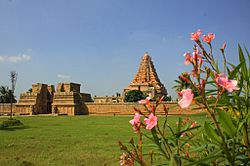
Conflict with the Palas
In 1019 CE, Rajendra's army marched through Kalinga towards the Ganges River. In Kalinga, the Chola forces defeated Indraratha, the ruler of the Somavamsi Dynasty. Rajendra used the help of the Paramaras and Kalachuris, who were enemies of Indraratha. Indraratha was defeated and likely killed.
The Chola army then reached the Pala kingdom of Bengal. They defeated Mahipala. The Chola army also defeated Dharmapala of Dandabhukti. They raided East Bengal and defeated Govindachandra. They also invaded the Bastar region.
Gangaikondacholapuram: A City of Victory
To celebrate his victory in the Ganges region, Rajendra built a new capital city. He named it Gangaikondacholapuram. He also built the Gangaikonda Choleeswarar Temple there. This temple was similar to the Brihadeeswarar Temple in Thanjavur.
Historians have debated if the Ganges campaign was a pilgrimage or a military one. Most now agree it was military. The Thiruvalangadu plates say the king built a "liquid pillar of victory". This refers to the Cholaganga tank, a large water reservoir.
The Chola expedition to the Ganges had a lasting impact. Some historians believe a chief who went with the Chola army settled in Bengal. He then founded the Sena Dynasty. It is also thought that the Karnata people of Mithila might be descendants of soldiers from the Chola army. Many Saivite Brahmins from Bengal were brought to the Chola country. Rajendra gave them land, and they settled in Kanchipuram and the Cauvery Delta.
Southeast Asia Campaign: Across the Ocean
Invading Srivijaya
Srivijaya was a kingdom in Sumatra, ruled by the Sailendra dynasty. At first, Srivijaya had friendly relations with the Chola Empire. However, the Khmer Empire king, Suryavarman I, asked Rajendra for help against the kingdom of Tambralinga. Tambralinga then asked Srivijaya for help. This led to the Chola Empire fighting against the Srivijaya Empire.
The Cholas were known for both trade and sometimes for taking goods by force. Srivijaya controlled two important sea routes: the Malacca and Sunda Strait. Srivijaya was a major trading empire with a strong navy.
Other Campaigns in Southeast Asia
In 1025 CE, Rajendra led Chola forces across the Indian Ocean. They invaded Srivijaya, attacking many places in Malaysia and Indonesia. The Cholas attacked Kadaram (the capital) and Pannai in Sumatra. They also attacked Malaiyur in the Malay Peninsula. Rajendra also invaded Tambralinga and the Gangga Nagara Kingdom. These are in modern Malaysia and south Thailand.
The Chola forces captured the last ruler of the Sailendra Dynasty, Sangrama Vijayatunggavarman. The Chola invasion weakened Srivijaya's power at sea. After this, the Chola Empire took over large parts of Srivijaya. This included its ports like Ligor, Kedah, and Tumasik (now Singapore). The Chola invasion helped Tamil merchant groups like the Manigramam and Ayyavole expand into Southeast Asia. For the next century, Tamil trading companies from southern India were very important in Southeast Asia.
The Chola invasion is mentioned in the Malay history book Sejarah Melaya. It calls Rajendra "Raja Chulan". Some Malay princes even have names ending with Cholan or Chulan. One record describes Rajendra as the King of Lamuri in north Sumatra. The Chola invasion led to the fall of the Sailendra Dynasty of Srivijaya. It also happened around the time the Buddhist scholar Atiśa returned from Sumatra to India in 1025.
Aftermath of the Southeast Asia Campaign
Even with the damage, the Srivijaya kingdom survived. The Chola invasion was short and mainly aimed at gaining wealth. It did not lead to direct Chola rule over Srivijaya. However, this invasion greatly weakened Srivijaya's power. It allowed new kingdoms like Kahuripan and Kediri in Java to grow. These kingdoms focused on farming rather than sea trade. Sri Deva became the new king, and trade continued. He sent a group to China in 1028 CE.
Even though the Cholas did not directly rule the region, trade changed a lot. Tamil traders became more active in Srivijaya's trading areas. These areas were traditionally controlled by Malay traders. The influence of Tamil guilds grew on the Malay Peninsula and the north coast of Sumatra.
With more Tamil guilds in the region, relations between Srivijaya and the Cholas got better. Chola nobles were welcomed in the Srivijaya court. In 1067 CE, a Chola prince named Divakara was sent as an ambassador to China. This prince, who was Rajendra's nephew, later became Emperor Kulothunga Chola I in 1070 CE.
Later, during a rebellion in Kedah, Srivijaya asked the Cholas for help. In 1068 CE, Virarajendra Chola launched a naval attack to help Srivijaya get Kedah back. Virarajendra put the Kedah king back on his throne. Kedah then accepted Srivijaya's rule again.
Rajendra's Passing
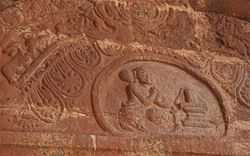
Rajendra I died in 1044 AD in the village of Brahmadesam. This village is in the Tiruvannamalai district of Tamil Nadu. An inscription by his son, Rajadhiraja I, tells us this. It also says that Rajendra's queen, Viramahadevi, performed sati (a ritual where a widow joins her husband in death). Her remains were buried in the same tomb in Brahmadesam. The inscription adds that the queen's brother, Madhuranthaka Parakesari Velan, built a water tank there to honor his sister.
Rajendra's Personal Life and Family
The Siddanta Saravali, a historical text, says that Rajendra was a poet. He wrote hymns praising the god Shiva. A commentary on this work states that Rajendra brought many Saivas (followers of Shiva) from the Ganges River area. He settled them in Kanchi and the Chola country.
Titles Rajendra Held
- After his successful campaign to the Ganges river, he earned the title Gangaikonda Chola. This means "The Chola who took the Ganges river".
- After his successful Southeast Asian campaign, he got the title "Kadaram Kondan". This means "He who took Kedah in Malaysia".
- He inherited the title Mummudi Cholan from his father. This means "Chola with three crowns". It was used by Tamil kings who ruled the three kingdoms of Cholas, Pandyas, and Cheras.
- To celebrate his conquests, Rajendra took other titles like Mudigonda Cholan and Irattapadikonda Cholan.
- Rajendra I also had the title Chalukya-Chudamani, meaning "Crest Jewel of the Chalukyas".
Rajendra's Family
Rajendra I had several queens. These included Tribhuvana (also known as Vanavan Mahadevi), Mukkokilan, Panchavan Mahadevi, Puteri Onangki, and Viramahadevi. Viramahadevi performed sati when Rajendra died in 1044 AD.
He had seven sons: Rajarajan, Rajadhiraja, Manukula Kesari, Sanga varman, Rajendra II, Rajamahendran, and Virarajendra. Rajarajan was the oldest but died young. Manukula Kesari died in 1021 CE during a war. Rajendra also had two known daughters: Arulmoli Nangaiyar Piranar and Ammangadevi. Ammangadevi became queen of the Eastern Chalukyas and was the mother of Emperor Kulottunga I.
Rajendra's Children
| Name | Mother | Birth
Date |
Death Date | Notes |
|---|---|---|---|---|
| Rajarajan | Mukkokilan Adigal | 988 C.E. | Unknown | |
| Rajadhiraja I | Mukkokilan Adigal | 994 C.E. | 1052 C.E. (aged 58) | Chola Emperor from 1044 C.E. to 1052 C.E.; Died in the Battle of Koppam against the Western Chalukyas. |
| Manukula Kesari | Tiribhuvana( Vanavan mahadevi) | 994 C.E | 1021 C.E. (aged 27) | Chola Governor of the Cheras from 1018 C.E. to 1021 C.E. |
| Sanga varman | Panchavan mahadevi | 995 C.E | 1059 C.E. (aged 64) | Chola Governor of the Mummudichola Mandalam (Polonnaruwa) from 1024 C.E. to 1059 C.E. |
| Rajendra II | Mukkokilan Adigal | 997 C.E | 1064 C.E. (aged 67) | Chola Emperor from 1052 C.E. to 1064 C.E.; Kept his father's lands. |
| Rajamahendra | Unknown | 1000 C.E. | 1060 C.E
(Aged 60) |
Co-Regent of the Chola Empire under his brother Rajendra II from 1056 C.E. to 1060 C.E. |
| Virarajendra | Mukkokilan Adigal | 1002 C.E | 1070 C.E. (aged 68) | Chola Emperor from 1065 C.E. to 1070 C.E. and King of Kadaram (Kedah) from 1067 C.E. to 1070 C.E.; Stopped several rebellions in Kadaram and Sri Lanka but lost control over Srivijaya. |
| Arulmoli Nangaiyar Piranar | Unknown | Unknown | Unknown | Queen of Kodumbalur king Elangovel Tirichirapalli. |
| Ammangadevi | Unknown | Unknown | Unknown | Queen Consort of Eastern Chalukya King Rajaraja Narendra; Mother of Chola Emperor Kulottunga I. |
Rajendra's Achievements and Legacy
Temples and City Building
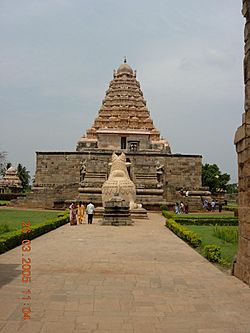
Rajendra built several important places. He built Gangaikondacholapuram to celebrate his victory over the Pala Dynasty. The city's name means "The town of the Ganga Bringer". It had an artificial lake, filled with water from the Kolerun and Vellar rivers. The city likely had two sets of walls for defense.
Rajendra made Gangaikonda Cholapuram his new capital. It remained the capital for the next 250 years. Rajendra built the entire city with many temples. He followed ancient Tamil building rules. These temples included ones for Dharma Sasta and Vishnu. However, most were destroyed later, except for the Brihadishvara temple. Digs have found remains of fort walls and palace ruins.
Rajendra also built a royal palace using burnt bricks. The ceilings were covered with flat tiles. The pillars were probably made of polished wood on granite bases. Iron nails and clamps have been found at the palace site. There is a tunnel that connects the palace to the temple.
Rajendra also made the Koneswaram temple in Trincomalee bigger. The temple to Bhadrakali also benefited from his rule. These temples are mentioned in old texts and stories.
Rajendra also expanded the Pathirakali Amman Temple in Trincomalee. Many pilgrims visited it during his reign.
Water Management and Infrastructure
Rajendra created a very good system for managing water. This system worked from the village level up. Temples and village groups played a bigger role in water management. Committees for tanks (eri-variyam) and gardens (totta-variam) were active. Temples used their large resources of land, people, and money for this.
Many water tanks were built during the Chola period. Rajendra built a huge tank called Cholagangam in his capital city. It was called the "liquid pillar of victory".
The Malay-language book Hikayat Iskandar Zulkarnain tells stories about Alexander the Great. It traces the family lines of some Southeast Asian royal families to Alexander, through Rajendra (called Raja Suran or Raja Chola). This is found in the Malay Annals.
Inscriptions and Records
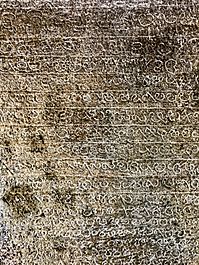
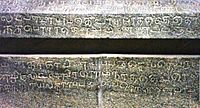
Many inscriptions from Rajendra's rule have been found. An inscription from the Adhipuriswara temple tells his birth star was Tiruvadarai. Donations were made to the temple to celebrate his birthday.
Another inscription from the Umamahesvara temple mentions donations by Alvar Parantakan Kundavai-Pirattiyar. This was during the third year of Rajendra's reign.
Important Officials and Governors
In 1018 AD, Rajendra made his son Rajadhiraja the heir to the Chola throne. Rajadhiraja led large military campaigns, like the wars against Pandya and Chalukya.
Key officials and governors during Rajendra's time included:
- Vallavaraiyar Vandyadevar
- Yadava Bhima "Uttama Chola" Miladudaiyar
- Gangaikonda Chola Miladudaiyar
- Dandanayakan Narakkan Krishnan Raman
- Marayan Arumoli "Uttama Chola" Brahmamarayan
- Talaigrama Indaladeva
Rajendra in Popular Culture
- India's merchant navy training ship TS Rajendra was named after him.
- The state government of Maharashtra suggested dedicating Rajendra's portrait to Mazgaon Docks.
- The video game Age of Empires II: Definitive Edition: Dynasties of India has a five-chapter story called Rajendra.
Books About Rajendra
- Vengayin Maindhan by Akilan tells the story of Rajendra's life.
- Gangapuri Kavalan by Vembu Vikiraman features Rajendra as the main character.
- Mannan Magal by Sandilyan is set during Rajendra's time.
- Gangai Konda Cholan by Balakumaran.
- Ulagam Vendra Cholan by Bharathika covers his war history and achievements.
Images for kids
-
Sculptures of Shiva and Parvati at Gangaikonda Cholapuram
See also
- Chola Empire
- Chola Navy
- List of Indian monarchs
- History of South India
- List of Tamil monarchs












